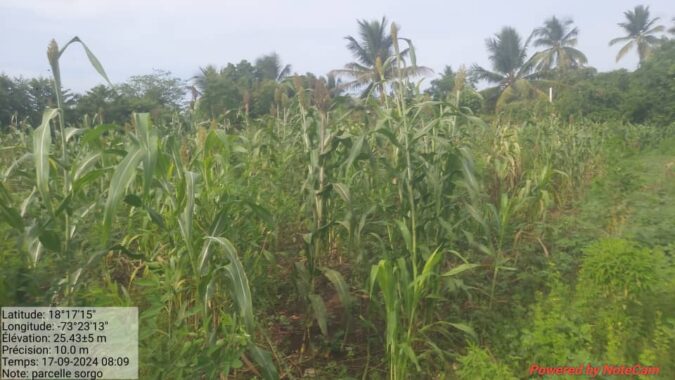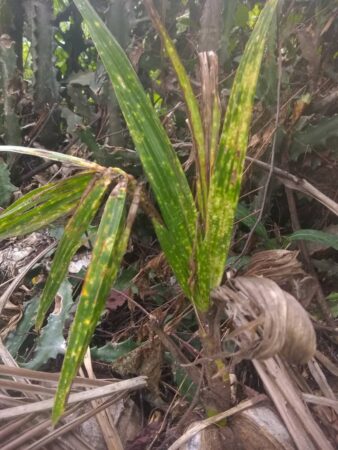The production of millet is of capital importance for Aquinois producers
The millet plantations of farmers in the commune of Aquin, in the South department, are prey to an invasion of yellow aphids, causing a considerable loss of income for producers of this cereal in the region.
Jean Marc, a farmer living in Morisseau, one of the municipal sections of Aquin, has been growing millet alongside his father since his youth.
The man faces major difficulties in continuing to cultivate sorghum, commonly called millet, due to the parasites that invade the gardens.
Read also : Perte de 60% de la production de petit mil : une catastrophe annoncée pour Haïti !
Last year, Jean Marc, a father of two in his fifties, planted about half a hectare of land – or 0.7 hectares – with little millet (pitimi), but the harvest was not enough to cover his family’s needs due to losses.

A little millet garden Aquin, September 17, 2024 | © Jean- Gardy Saül
“We’ve been facing this situation for several years now. Because of this pest, many planters have abandoned sorghum cultivation in favor of other crops, such as corn,”observes Jean Marc, who says he also plants corn and other agricultural produce, enabling him to provide for his family.
Darilus Etienne heads the Jubilée farm, founded with partners in 2012 and located in Lomont, a locality in the commune of Aquin, and has had to abandon the cultivation of little millet due to poor harvests.
The farm, which covers 100 tiles of land – or 129 hectares – now produces beans, corn, and, above all, peanuts. The production of pearl millet is of paramount importance to Aquinois farmers.
Thanks to its glycemic index of 71, this product is highly appreciated by diabetics. In Haiti, the most widespread cereal crops are corn, rice, and sorghum.
The most widely grown cereal crops in the country are also corn, rice, and sorghum. In 2019, sorghum production was estimated at 9,184 metric tons, according to a report by the Ministry of Agriculture.
Little millet is used in the manufacture of alcoholic beverages, such as beer.
“We’ve been facing this situation for several years now. Because of this pest, many planters have abandoned sorghum cultivation in favor of other crops, such as corn”
According to Gaël Pressoir, Director of the Haitian Center for Innovation in Biotechnology and Sustainable Agriculture (Chibas), two main pests attack little millet: the yellow aphid and the midge fly – a dipteran insect whose larvae live as parasites on cereal plants or fruit trees, causing significant damage.
Yellow aphids feed on the sap of little millet, releasing an oily, sweet secretion that attracts other insects such as flies and ants. This secretion blackens the plant and impairs its development.
According to eyewitness accounts gathered by AyiboPost, the phenomenon was already present well before Hurricane Matthew hit the South department in 2016.
After the disaster, the damage intensified, with entire plantations of little millet turning yellow from pests. Nearly five million people are food insecure in Haiti, according to the latest statistics published by the National Coordination for Food Security.
Renel Polot, a member of the municipality of Aquin, notes that little millet is an essential crop for the region.
Read also : Les plantations du Sud sévèrement frappées par le réchauffement climatique
“When the aphid attacked the little millet, growers recorded huge losses in terms of yield,” reports the mayor.
Agronomist Wilbert Lubin, who runs a farm in Fond-des-Nègres, also mentions other pests such as shoot moss, termites, grasshoppers, fall armyworms, stem borers, and panicle pests.
In 2017, Haitian researchers from CHIBAS at Quisqueya University introduced disease-resistant varieties called Pa pè pichon. This feat has enabled farmers to thwart pest attacks, reviving little millet production.
“When the aphid attacked the little millet, growers recorded huge losses in terms of yield,” reports the mayor.
Agronomist Darilus Etienne experimented with the Pa pè pichon little millet variety on an area equivalent to 42 tiles of land (about 54 hectares). But the experiment was not entirely conclusive.
“Only 10 tiles produced satisfactory results,” he relates, adding that the plantation was attacked not only by pests, but also by birds. To grow successful crops, “a planter must use a lot of pesticides”.
According to Dr. Pressoir, it is possible that aphids are present in Aquin and affecting the crops. He points out that “aphids attack even resistant varieties. However, these varieties in the presence of the parasite, and even if their yield is reduced, will still produce an appreciable yield, unless they are attacked by midge flies.”
According to Gaël Pressoir, there are two possible explanations for the problems encountered with the little millet varieties grown by farmers in the Aquin commune. The first possibility, he says, is that farmers may be growing old varieties that are not resistant to pests.
“We’ve gone more than two years without the presence of the parasite in our area,” explains Pressoir, who says he has seen the return of old sorghum varieties susceptible to the yellow aphid planted by farmers.
The second hypothesis, continues the researcher, is that over the last two years, the country has experienced numerous episodes of drought, alternating with rainy periods, which favors the parasite’s development.
According to the researcher, it could be that one or both of these scenarios exist at the same time.
The agronomist also points to the presence of another disruptive agent in the production of little millet in Haiti. This is the midge fly, which reproduces in 21 days, laying eggs inside the plant’s flowers, thus preventing the seeds from developing.
This gives farmers 20 days to plant, after the rains have started or after the first seedlings have been sown.
“If everyone doesn’t manage to plant within this 20-day period, whoever plants last will have to deal with the midges,” explains Pressoir.
This rule doesn’t apply if farmers plant the pearl millet, commonly known as pitimi photopériodique or pitimi lane.
“No matter when you choose to plant the pearl pitimi, it will produce the same yield. So pitimi lane has a definite advantage over midges.
Little millet is not the only crop attacked by pests in the region.
Coconut trees – an essential crop for the local population – as well as avocado, lemon, and mango trees, are also under attack.

A coconut tree attacked by cochineal | © Gaël Pressoir
Richardly Fleury, a local resident, ventured into the business of selling coconut, mango, and avocado seedlings to growers.

A nursery attacked by cochineal. | © Richardly Fleury
The man observes that the coconut palms no longer bud like they used to. What’s more, the fruit is smaller, and the crop is in decline in the Aquin area. In 2020, Fleury left the Haitian capital to settle in Aquin, where he runs his father’s informal business specializing in the preparation and sale of fruit seedlings.
“The price of coconuts has tripled on the market. A coconut now sells for 200 gourdes and a dozen for 2,500 gourdes,” he tells AyiboPost. “My father use to be able to sell over 10 dozen coconuts a day, but now it’s no longer possible. »
Read also : Les cocotiers d’Haïti risquent la disparition
According to Gaël Pressoir, a combination of factors such as drought, poor plant nutrition, and the El Niño and La Niña phenomena could be behind these attacks.
In the face of these challenges, some growers are trying to adapt.
“The price of coconuts has tripled on the market. A coconut now sells for 200 gourdes and a dozen for 2,500 gourdes”
Agronomist Wilbert Lubin, who owns a pig farm and raises various animals, confides that last year he planted 3,000 square meters of little millet and pigeon peas without suffering any losses.
“I have my own way of getting around the problem,” he tells AyiboPost. “If I plant small millet this year, next year I’ll grow something else. »
Other farmers are turning to agricultural crops or livestock that offer them more guarantees.
Jean-Gardy Saül, an agronomist working with farmers in the region, explains that his father had stopped growing little millet because of these pests. It was only in 2023 that some locals began to regain confidence and started replanting the little millet, although the taste of the Pa pè pichon variety is not the same as that of the Madan Michel little millet once favored by farmers.
Researchers are exploring other alternatives.
Gaël Pressoir notes that the CHIBAS laboratory is currently developing little millet varieties that are much more resistant than Pa pè pichon.
These little millet varieties are created from the local little millet and resistant varieties developed in the laboratory to meet the country’s agricultural challenges.
Cover image | ©FAO/Issouf Sanogo
► AyiboPost is dedicated to providing accurate information. If you notice any mistake or error, please inform us at the following address : hey@ayibopost.com
Keep in touch with AyiboPost via:
► Our channel Telegram: click here
► Our Channel WhatsApp: click here
► Our Community WhatsApp: click here







Comments